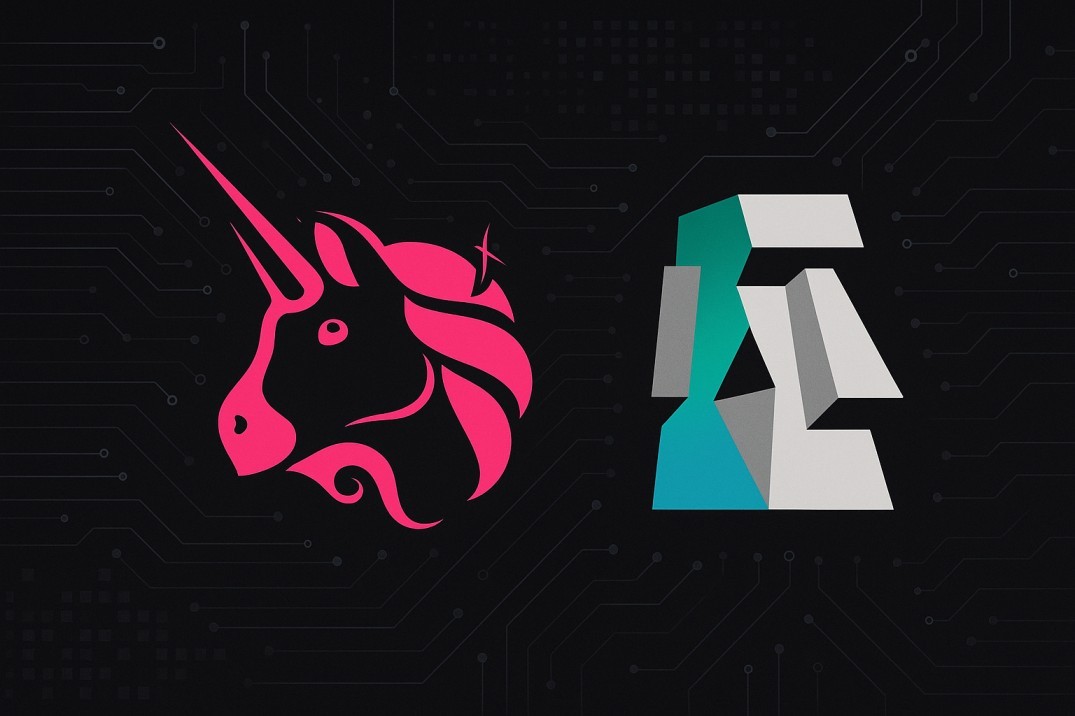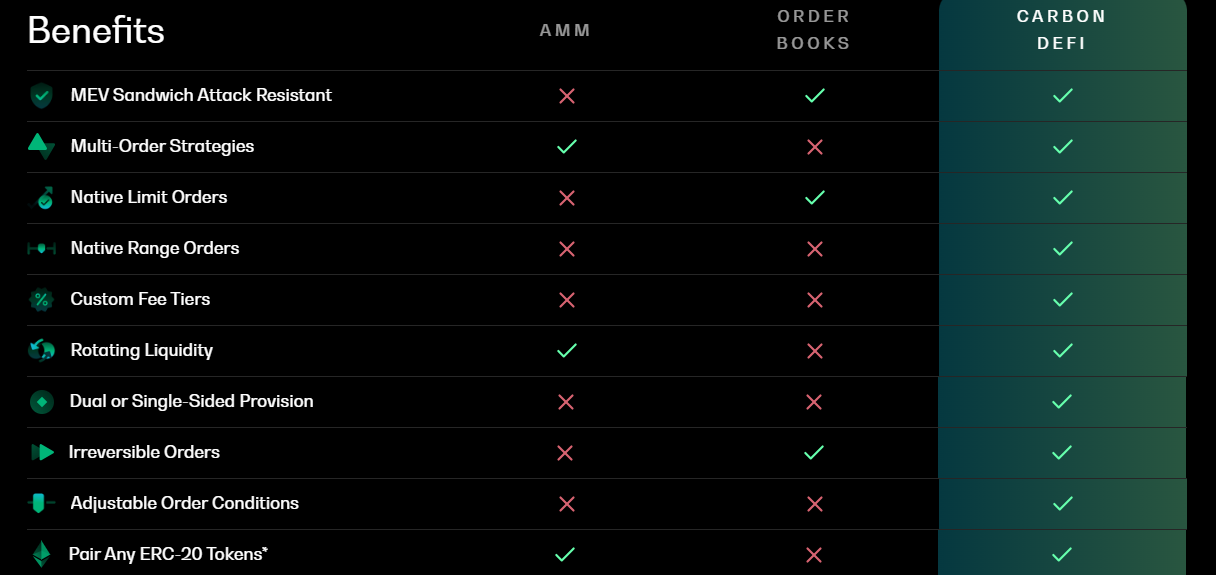TL;DR
- Traditional AMMs and even advanced models like Uniswap V3 have limitations in strategy flexibility, liquidity control and front-running risk.
- Carbon DeFi (built by Bancor) introduces features such as native limit & range orders, auto-compounding concentrated liquidity, MEV resistance and full on-chain strategy automation.
- Uniswap V3 pioneered concentrated liquidity and fee tiers, but it imposes practical constraints-preset fee tiers, non-adjustable positions without withdrawal/re-deposit, and exposure to sandwich attacks.
- Carbon DeFi's architecture gives traders and LPs far more precision: choose your own fee/spread, adjust positions without full withdrawal, use recurring buy-low/sell-high loops, and protect against MEV.
Decentralized exchanges (DEXes) are the living labs of DeFi, reflecting both the progress and the friction of on-chain trading. From the early days of simple swaps and liquidity pools, we've moved into an era where sophisticated strategies, risk management, arbitrage, front‐running and MEV all dominate the narrative. Yet many DEXes are still built on models that offer limited control and leave users exposed to inefficiencies.
Enter Carbon DeFi. Rather than being just another AMM redux, it's built with the mindset of active traders, strategy builders and liquidity providers who want more than "swap now, hope for best." With features like native limit orders, range orders, recurring strategies and built-in arbitrage infrastructure, Carbon deconstructs many of the compromises of traditional AMMs.
On the other side, Uniswap V3 remains a giant and pioneer-its concentrated liquidity model changed the game in 2021 for LPs. But as the space evolves, the question becomes: will Uniswap V3's framework be enough for the next decade of DeFi? Or will newer designs like Carbon DeFi set the standard?
Let's take a deeper dive into how these two platforms compare-and why Carbon DeFi might be overtaking the race.
What Uniswap V3 Built - And What It Still Leaves Unsolved
Uniswap V3 introduced some landmark innovations. Instead of spreading liquidity uniformly across the entire price curve (as V2 did), V3 enabled LPs to concentrate liquidity within a custom price range. This concentrated liquidity model improved capital efficiency and gave LPs more strategic power.
For traders, it meant tighter spreads, better execution and improved depth-assuming the pool's price stayed in the chosen range. But several structural and practical limitations remain:
- Non-adjustable positions without withdrawal: When an LP wants to change the price bounds or strategy, they often must withdraw and redeposit-incurring gas costs and downtime.
- Preset fee tiers: V3 offers fee tier choices (e.g., 0.05 %, 0.3 %, 1 %), but once chosen, you're limited. That restricts fine control over profit margins.
- Exposure to MEV & sandwich attacks: Because liquidity is visible and often predictable, trading strategies can be exploited by bots and searchers. Research has flagged the risk inherent in concentrated liquidity designs.
- Liquidity still bound by pre-defined price buckets (ticks): LPs must choose from discrete price intervals ("ticks"), which may limit flexibility and create inefficiency when price ranges shift drastically.
In summary: Uniswap V3 improved on its predecessor significantly, but the trade-off is that LPs and traders still face operational friction, risk exposure and limited execution control.
Why Carbon DeFi Exists: A New Model for On-Chain Strategy
Recognizing the gaps in AMMs and V3-style DEXes, Carbon DeFi sets out a new paradigm built around strategy, automation, precision and protection. Instead of treating liquidity provision as "deposit and hope for volume," Carbon introduces tools tailored for active traders and liquidity providers who want:
- Native limit and range orders on-chain: Set a price threshold for buy or sell with full certainty and on-chain trust.
- Adjustable positions without full withdrawal: Move your price bounds or change your strategy live, saving gas and time.
- Recurring strategies: Automate loops like buy-low/sell-high, rotate capital and compound without manual oversight.
- Custom fee/spread tier: Rather than being limited to preset tiers, users can select their own spread based on their strategy.
- MEV and front-running resistance: With asymmetric liquidity curves and liquidity design aimed at reducing visibility of order-flow, Carbon builds resilience into trading logic.
In effect, Carbon de-couples strategy from the primitive "trade now" mindset. It gives users on-chain tools closer to what a pro-trader or hedge fund would expect, but in a decentralized, transparent environment.
Carbon DeFi vs Uniswap V3: A Comparison of Depth

Let's look at side-by-side how these two systems diverge in design, capability and user impact:
Capital Efficiency & Control
Uniswap V3's concentrated liquidity is a leap over uniform pools-but it still requires LPs to manage tick boundaries, has limited fee choices and is vulnerable to price range exit. Academic work shows that while V3 improved efficiency, the strategic complexity for LPs remains high. Carbon DeFi builds on that by enabling fully custom price ranges, auto-compounding, adjustable positions, and automation of strategy loops-giving both traders and LPs far more control over outcome. AlsoCarbon DeFi's architecture gives it unmatched efficiency. As recently Carbon DeFi announced:
Strategy Support
Uniswap V3 is largely passive once position is set: you supply liquidity, hope traders use it, and manage range changes if needed. Carbon DeFi supports active strategy creation: limit orders, range orders, recurring orders, auto-compounded concentrated liquidity. No existing mainstream AMM offers this full suite on chain.
Resilience & MEV Exposure
Uniswap V3 has improved risk relative to earlier models, but its visible liquidity curves and predictable behavior make it still vulnerable to MEV and sandwich attacks. Carbon's design includes asymmetric liquidity curves and hidden strategy logic-reducing attack surface, protecting execution and supporting traders who care about edge and privacy.
Gas & Usability
Uniswap V3 requires LPs to frequently withdraw and redeposit to change strategy, incurring gas costs and friction. Carbon DeFi offers live adjustment of positions without full withdrawal, making repositioning cheaper and more seamless. Liquidity is more flexible, strategy-oriented and efficient.
Platform Integration and Privacy Extension
Carbon DeFi isn't just about strategy; it's also about infrastructure. Deployed on COTI and supported by Arb Fast Lane and cross-chain plumbing, it provides privacy-enhanced legitimacy, making it attractive for token projects and institutional flows.
Why Carbon DeFi Stands Apart
Compared to traditional AMMs and order book models, Carbon DeFi combines the best of both worlds while introducing features neither can offer.

It’s MEV sandwich–attack resistant, supports multi-order and range order strategies, and allows users to create custom fee tiers with adjustable order conditions. Traders can also set irreversible orders, rotate liquidity, and provision either single- or dual-sided liquidity, offering more control and flexibility.
Unlike most protocols, Carbon DeFi keeps everything fully on-chain and supports pairing of any ERC-20 tokens, making it a versatile, secure, and strategy-rich platform for DeFi traders.
Adoption and Why the Timing Is Right
Carbon DeFi enters the market at a moment when DeFi users are demanding more control, privacy, and automation. The appetite for on-chain strategies has grown beyond basic token swaps, and liquidity providers want tools that work more like programmable trading systems than static pools. Built by Bancor and powered by COTI's privacy-centric infrastructure, Carbon DeFi fits perfectly into this shift. Its asymmetric liquidity design, on-chain automation, and MEV-resistant framework address many of the weaknesses that long-time DEX users have learned to live with.
Uniswap V3 may still dominate in raw market share, but the direction of DeFi is changing. As institutional participants and advanced retail traders enter the space, the demand for strategy-rich, capital-efficient, and risk-protected environments is rising fast. By combining COTI's encrypted execution layer with Bancor's proven DeFi expertise, Carbon DeFi positions itself as the natural evolution of AMMs-one that finally treats decentralized trading as a serious, customizable discipline rather than a passive liquidity game.
The timing couldn't be better. Markets are consolidating around quality, not quantity-and Carbon DeFi's design speaks directly to that maturity.
Challenges & Caveats
Of course, no system is perfect overnight. Some potential headwinds for Carbon DeFi include:
- Ecosystem depth & liquidity scale: Uniswap has years of network effects, deep liquidity and broad deployment. Carbon must attract sufficient volume, pairs and LPs.
- User education & complexity: With more features comes complexity. Traders and LPs must adjust to new tools-limit orders, range orders, recurring loops-that may require a learning curve.
- Security & decentralisation maturity: As Carbon grows, audit trail, governance decentralisation and risk of strategy-automation must be robust.
- Competition and innovation: Other DEXes may copy or extend features. The frontier of DeFi is fast-moving; Carbon must continue to iterate and scale.
Final Thought
In the evolving world of DeFi, trading and liquidity provision are no longer about "just deposit and swap". They are about strategy, automation, precision, risk-control and edge. Uniswap V3 did much of the hard work in that transition. But the next phase demands more-native order types, flexibility, on-chain automation and MEV resistance.
That's why Carbon DeFi, built on COTI and powered by advanced arbitrage infrastructure and strategy tooling, may well be overtaking the race. It combines the fluid simplicity of AMMs with the strategic control of order-book systems-without losing decentralization.
If you're building, trading, providing liquidity or thinking about the next generation of DeFi infrastructure, Carbon DeFi deserves your attention. It might just become the new standard for what a DEX should offer.
READ MORE : COTI V2’s Secret Weapon: Garbled Circuits Explained for the Web3 Era










